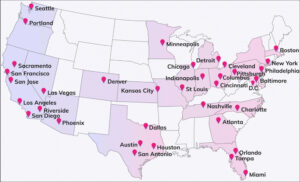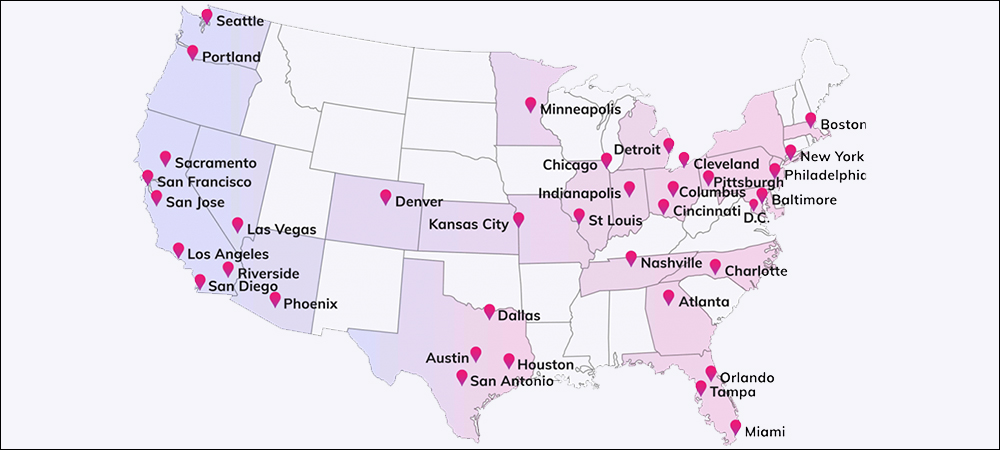A new LoRaWAN-based Internet of Things (IoT) network is being built across the United States as part of a partnership between network operator Everynet and communications infrastructure company Crown Castle. Everynet has a 15-year commitment to the LoRaWAN network, intended to ensure its use for a wide variety of deployments. Crown Castle installs the hardware to capture the transmissions for devices and sensors, while local service providers can then build out solutions for customers, such as utility companies and logistics providers.
Everynet will also work with mobile network providers, mobile virtual network operators and Internet service providers that will offer services and apps to leverage the IoT network. The system is expected to be taken live in most major U.S. cities by the end of 2021, the company reports. Additionally, the firm is collaborating with Semtech, a provider of LoRaWAN integrated circuits that will be leveraged during the nationwide buildout.

Everynet is launching an IoT network starting with the top 36 metropolitan areas in the United States. (Photo: Business Wire)
A Netherlands-based company, Everynet provides LoRaWAN networks in Europe, Brazil, Indonesia and Puerto Rico. The Crown Castle announcement, however, represents its first major installation in the mainland United States. With the deployment, Everynet will provide IoT coverage for businesses and residents throughout 36 major cities. In the near term, the result is likely to be more IoT deployments across the country by utilities for smart metering, smart-city and smart-building systems, and supply chain management solutions.
Crown Castle claims to be the largest provider of communications infrastructure in the United States, with 40,000 cell towers and nearly 80,000 route miles of fiber. Everynet trains the crews who are installing the LoRaWAN gateways on its cell towers, and with this infrastructure, Everynet expects to offer a network with granular and ubiquitous coverage to the cities in which the deployment is beginning.
Incorporated in 2014, Everynet was among the first members of the LoRa Alliance. In 2017, the company pivoted from private LoRa-based solutions to providing public networks, says Lawrence Latham, Everynet’s CEO. This business model, he explains, enables the widescale availability of a technology designed to help companies worldwide build out IoT solutions. The question the company had asked itself, Latham says, is “Do you use tools to help other people, or do you use them for your own private benefit?” It opted for the former option, and the first public network was provided in Brazil, followed by another in Indonesia.
At this time, Latham notes, 2G and 3G cellular network technologies are being retired, leaving an opening for other IoT technologies that can provide reliable coverage. “We need to go fast,” he states. While the 2G and 3G sunset is underway, Latham adds, LoRa is ideally suited for systems that have been using these technologies, as it transmits relatively small amounts of data and requires low bandwidth and low power. The IoT network, he says, will not be sunsetting in the future.

Lawrence Latham
For those wishing to build an IoT solution, Latham says, “The number-one issue, when you’re looking at any type of technology use, is availability.” Only if the technology is available, he explains, can users begin to examine use cases, the economics of technology purchases and how much data transmission might be possible. Deployment of the network is currently taking place throughout the United States.
Going forward, Everynet intends to announce each city’s connectivity as it is completed. The company says it will not consider the solution live until it provides the quality of coverage that enables location identification and full coverage throughout every city. “This is a truly carrier-grade network with meaningful SLAs [service level agreements] with built-in redundancy,” he states. Once the network goes live in each city, it will offer the full 64 channels of ISM radio bands spectrum allotted by the FCC.
By November of this year, the company reports, key logistics points that are not covered in big cities will be live as well, assuming all goes as planned. The network will then continue to grow beyond that, to smaller communities, and utilities will be able to use the system for water and gas metering. For instance, metering data can be collected without wired power, if a utility attaches a battery-powered sensor to each meter and forwards the readings to the LoRaWAN gateways. Companies such as Mueller and Neptune are already using LoRa, Latham says, and the company foresees the monitoring of a water system to manage valves, subsystems and flooding detection. “It not going to take the place of cellular or RFID,” he states. “It’s additive.”
For supply chain management, businesses will be able to deploy a LoRaWAN device that could be attached to a container or pallet. Everynet is working with several pallet companies to build LoRa connectivity into their products so that customers will be able to view the locations of merchandise moving through the supply chain. At present, Latham says, the supply chain is only about five percent digitized. With cities using the network, pallets or cartons of goods could be tracked, whether indoors or outdoors.
Additionally, LoRaWAN network corridors will be deployed at key points along interstate connections so that goods can be tracked as they move between warehouses or ports by highway or rail. The value will be a better view into the movements of goods, Latham says—for instance, monitoring cold chain products before they reach a store in order to reduce the risk of waste.
Some LoRaWAN private networks are already in place in the United States, but the Everynet network will be the first national network that U.S. users can access, according to the company. Latham foresees private and public networks being used in conjunction for some use cases, such as supply chain management. “We work with a lot of people in the LoRaWAN ecosystem,” he says. “Part of our culture is cooperating with everyone, because we have a massive job to do. That means working with members of the ecosystem already there.”
While Everynet provides the network, Lathan adds, it can also help users address questions as they build out the appropriate solutions. The network company offers consulting for potential users, based on the need for hardware and software, and it will assess each use case and match users to the proper technology providers. Commonly, businesses complete a proof of concept and then seek a way to scale up to a full deployment.
Everynet predicts that the network will work well in conjunction with other IoT technologies. For instance, companies may leverage 5G or RFID technologies in tandem with LoRaWAN devices. In one such scenario, RFID tags could be applied to products on a pallet, while LoRaWAN devices would be attached to the pallets. “The first step is to talk to the pallet,” Latham says, “but the real goal is to start looping in other technologies.” LoRaWAN alone won’t solve all problems, he adds—the question is “How do we integrate with these technologies to do cool stuff?”
The goal, according to Latham, is to have a massive impact on supply chain visibility at a viable cost. “For us,” he says, “part of the way to scale and make IoT massive is by building this big, shared network that is neutral-host, which people can take advantage of.” The company thinks the low-cost, neutral-host business model will make the IoT rollout significant for American companies. “We’re never going to compete with our channel partners—what they need is a network in place that is resilient, available and affordable.”


